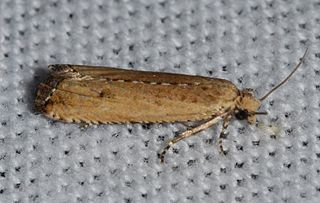
Bactra lancealana is a moth of the family Tortricidae found in Europe. The moth has a wingspan of 11–20 mm. The forewings are pale ochreous or ochreous- brownish, costa strigulated with darker ochreous or dark fuscous; a spot in disc at 1/3 and an angular mark beyond middle dark fuscous, often obsolete, sometimes forming a more or less complete dark median streak from base to apex; central fascia sometimes indicated on costa. Hindwings are grey. The larva is greenish or whitish-fleshcolour; head and plate of 2 black. It is very similar to Bactra furfurana.

Bactra is a genus of moths belonging to the subfamily Olethreutinae of the family Tortricidae.

The Bactrini are a tribe of tortrix moths.

Bactra venosana, the nutgrass borer or nutsedge borer, is a moth of the family Tortricidae. It was first described by Philipp Christoph Zeller in 1847. Julius von Kennel provides a full description. It has a wide distribution, from southern Europe, North Africa and Asia Minor to India, Sri Lanka, southern China, Malaya, Australia and into the Pacific where it is found on Java, Borneo, the Philippines, Taiwan, Timor, the Solomons, the Carolines and Fiji. It was introduced to Hawaii in 1925 to control nutsedge. It is now found on Kauai, Oahu, Molokai, Maui, Lanai and Hawaii.

Dichelopa panoplana is a moth of the family Tortricidae. It is known from Australia, where it widespread in semiarid areas from southern Queensland to South Australia.
Lobesia extrusana is a species of moth of the family Tortricidae. It is found in Australia, where it has been recorded from Queensland and New South Wales.
Apocydia pervicax is a species of moth of the family Tortricidae. It is found in Australia, where it has been recorded from Queensland, New South Wales and the Northern Territory.
Toonavora aellaea is a species of moth of the family Tortricidae. It is found in Australia, where it has been recorded from Queensland and New South Wales.
Statherotis euryphaea is a species of moth of the family Tortricidae. It is found in Australia, where it has been recorded from Queensland and New South Wales.

Bactra optanias is a species of moth of the family Tortricidae first described by Edward Meyrick in 1911. It is found in Papua New Guinea, Australia, New Zealand, Java, Tahiti, Sri Lanka, New Caledonia, the Caroline Islands, the southern Mariana Islands, Rapa Iti and Micronesia.
Bactra anthracosema is a species of moth of the family Tortricidae. It is found in Australia, where it has been recorded from the Northern Territory.
Bactra testudinea is a species of moth of the family Tortricidae. It is found in Australia, where it has been recorded from Queensland.
Holocola phaeoscia is a species of moth of the family Tortricidae. It is found in Australia, where it has been recorded from Queensland and New South Wales.
Melanodaedala scopulosana is a species of moth of the family Tortricidae. It is found in India, Myanmar, Thailand, Vietnam, Japan, the Solomon Islands, Papua New Guinea and Australia, where it is found along the eastern coast from New South Wales to the Cape York Peninsula in Queensland.

Bactra bactrana is a species of moth of the family Tortricidae. It is found on the Canary Islands, Sicily and Malta and in southern Spain, Portugal, southern Italy, France, Greece, Morocco, Algeria, Egypt, Asia Minor, Arabia, Iraq, Iran, the Caucasus, Afghanistan, the Caspian area, Tajikistan, Kyrgyzstan, Uzbekistan, Pakistan, India, the Republic of Congo, Madagascar, Sudan and Gambia.
Dichelopa dichroa is a species of moth of the family Tortricidae. It is found in Australia, where it has been recorded from South Australia, Victoria and New South Wales.
Bactra blepharopis is a species of moth of the family Tortricidae. It is found in New Caledonia and Australia, where it has been recorded from New South Wales and Queensland.

Bactra verutana, the javelin moth, is a species of moth of the family Tortricidae. It is found in North America, where it has been recorded from Florida, Texas, Mississippi, North Carolina, Indiana, Missouri, Ontario, Alberta, Quebec and Labrador. It is also found in Cuba, Mexico, Panama, Paraguay, Puerto Rico, Mozambique and South Africa. The habitat consists of prairies, aspen parkland, foothills and mixed wood areas.
Bactra stagnicolana is a moth of the family Tortricidae. It is known from Angola, Comoros, Democratic Republic of Congo, Kenya, Madagascar, Malawi, Mauritius, South Africa South Africa and Zimbabwe.

Bactra furfurana, the mottled marble, is a moth of the family Tortricidae described by Adrian Hardy Haworth in 1811. It is found in the Nearctic and Palearctic realms.







